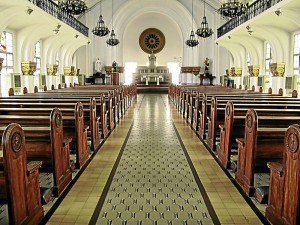
“The Future Begins Here” is not your regular history book.
It was published to celebrate the 100-year story of De La Salle University, an event marked by a yearlong celebration that culminates in March 2012.
The book captures the spirit of the university—that of an ever young, dynamic, bold and unique educational institution that keeps pace with the changing times while being true to the ideals of its founder, John Baptist de la Salle.
Most importantly, the book expresses the spirit of its graduates who have contributed to change in the Philippines.
Some did change in a big way, high-profile alumni who joined the public sector to actively lead the country. Others showed the way and blazed trails in their chosen professional fields.
Many chose the quiet path of causing change through work with charity groups, or within their own families.
Whatever their path, all followed his or her moral convictions honed by their De La Salle days. Changing the world for the better while doing it without much fanfare is one of the values De La Salle teaches its students.
Momentous arrival
In “The Future Begins Here,” the De La Salle story is carried out in many ways—through the thematic approach which features the different strengths that made the university what it is today, beginning with the story of the Christian Brothers who have selflessly given of themselves in the name of education, role models and mentors during our school days who evolved, over the years, into our good friends.
It is the story of De La Salle’s 100-year journey, beginning with the momentous arrival of the Christian Brothers in 1911. The journey continues on as a never-ending commitment to be the best university for young men and women who are in search of an excellent education.
The story includes short bio clips of some of the school’s illustrious alumni in business, public service, the arts and culture, science and technology, environmental protection and other fields; a group of individuals with different persuasions all linked through the distinct La Sallian outlook that seamlessly marries the past to the present to the future.
Nowhere is this outlook of continuity more evident than in the landmark St. La Salle Building, centerpiece of the Taft Avenue campus, listed on the 2008 edition of “1001 Buildings You Must See Before You Die: The World’s Architectural Masterpieces,” by Mark Irving.
Architectural achievement
The book ranks St. La Salle Building with the world’s architectural masterpieces as varied as the Chateau de Chambord in the Loire Valley; Borromini’s San Carlo alle Quattro Fontane in Rome; the Berlin Reichstag by Sir Norman Foster; the Walt Disney Concert Hall in Los Angeles by Frank Gehry; and the Yale Art Gallery by Louis Kahn.
Now that an international publication has pointed out how special the St. La Salle Building is, the generations of alumni and students who had taken it for granted should change the way they look at the building because it is difficult to appreciate something that we see every day.
Its architect, Tomás Mapúa, adapted classical Greek architecture, simplified the style to fit the modern lifestyle and building technology of 1920s Manila, ably adapting a Western architectural style to suit the Philippine tropics.
That is the architectural achievement of St. La Salle Building.
The building’s perfect attunement to tropical climate gave us body comfort in the four years I spent going to school there.
In classrooms separated by huge wood-and-capiz folding doors which opened out to wide verandahs on two sides, natural breeze flowed through the large doors to cross-ventilate our classrooms. The wide verandahs kept us dry when it rained.
Attend to nature
In those days (it is enough to say that I mark 50 years from my high-school graduation this March), we looked over tree-lined Taft Avenue, past the low-rise residential neighborhoods that surrounded the school.
Our view unobstructed, we could see clouds in the clear sky and then watch them turn into rain and typhoons when seasons changed.
We were in tune with nature all day long.
Air was fresh. Pollution was unknown. Now pollution is all the Taft Avenue campus knows. St. La Salle Building, I admit, has always been a great part of my life, my home for four years, where a lot of what I know and whom I know comes from.
“The Future Begins Here” chronicles how the grass can never be greener (there’s no other color, believe me) on the other side of the fence. It’s always been greenest on our side.
Chapters are written by La Sallians Butch Dalisay, Toti Villalon, Elfren Cruz, Quinito Henson, Rene de Castro, Alvin Culaba, Carla Pacis, Charlson Ong, Roel Cruz and Isagani Cruz.
Studio 5 Designs published the book and its design is by BG Hernandez.
This book is dedicated to the thousands of alumni who have crossed the halls of De La Salle, to each one of them who now bring honor to their alma mater.
“The Future Begins Here” will be launched at the Manila Polo Club, 6 p.m., on March 7. La Sallians are invited. All net proceeds from the sale of the DLSU Centennial Book will benefit the One La Salle Scholarship Fund.
E-mail the author at pride.place@gmail.com.